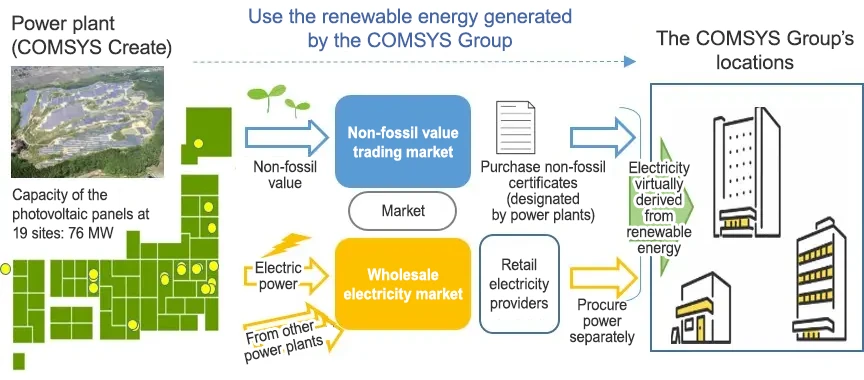Contribution to Climate Change Measures
We support the recommendations of the TCFD and the Paris Agreement, a new international framework succeeding the Kyoto Protocol to reduce greenhouse gas emissions starting in 2020. We are committed to proactively disclosing information related to climate change and achieving our emissions reduction targets.
As part of our materiality (key issues), we have identified "Making efforts for global environmental conservation" and are working to reduce greenhouse gas emissions and minimize environmental impact through our business activities. Furthermore, we aim to contribute to the realization of a sustainable society by promoting renewable energy and advancing initiatives that reduce environmental burdens.
Response to the TCFD recommendations
Basic Approach

Regarding “making efforts for global environmental conservation”, which is a material issue the COMSYS Group has identified, the Group values actions to prevent climate change. In November 2021, the Group stated its alignment with the Task Force on Climate-related Financial Disclosures (TCFD) and joined the TCFD Consortium.
To promote sustainability-oriented management and realize a sustainable society, we disclose information in line with the TCFD recommendations and engage in activities to mitigate climate change-related risks and create opportunities.
In October 2023, we were certified as reaching the 1.5 °C target by the Science Based Targets (SBT) Initiative in terms of our GHG emissions reduction target for FY2030. We push forward with carbon neutrality activities.
The COMSYS Group calculates in-house GHG emissions (Scopes 1 and 2) and GHG emissions from supply chains (Scope 3) on a group-wide basis and works to reduce Scope 1 and 2 emissions. Scope 3 emissions are increasingly visualized and refined in an effort to spur the reduction of emissions throughout the supply chains.
Governance
Board of Directors’ supervision of climate-related risks and opportunities
The COMSYS Group considers environmental issues including climate change as an important matter concerning the Group’s management strategy.
Sustainability-oriented management and actions against climate change are important issues necessitating the management’s judgment in a business activity. For this reason, the Group has the Sustainability Committee chaired by President, Representative Director and consisting of Directors and Administrative Officers (including presidents of supervisory business companies), under the supervision of the Board of Directors.
Meeting twice a year or more, the Committee formulates strategies and policies and sets milestones and targets regarding sustainability issues including those relating to climate change. Furthermore, it reviews the initiatives and achievement of numerical targets and reports the results of review to the Board of Directors.
Risk Management
Evaluation of climate-related risks and awareness about the need for action
Heavy rain, flood, intensification of natural disaster and other events in recent years have been expanding the scope of threat that a company must consider more than ever.
Amid the changing business environment, the COMSYS Group holds a meeting of the Risk and Compliance Committee whenever necessary with an aim to keep updated on the ever-diversifying risks and manage the risks for two purposes: minimization of damage and business continuity. The Committee is chaired by President, Representative Director and consists of Directors and Administrative Officers (including presidents of supervisory business companies).
Sustainability Committee assumes a supervisory role on risks including climate change, reviews and analyzes their impact on the COMSYS Group and implements measures through discussion.
Strategies
Identifying short-, medium- and long-term climate-related risks and opportunities and their impact on the Group’s business operations
The COMSYS Group believes that the evaluation of business impacts related to risks and opportunities from climate change, as well as the formulation of countermeasures, are essential for us to contribute to society by “constructing infrastructure that supports an affluent lifestyle,” as stated in our Management Philosophy, and for ensuring the sustainability of our business.
The COMSYS Group conducts scenario analyses based on the scenarios below with the goals of staying up to date on the impact of climate change on the Group’s business operations and identifying climate-related opportunities and risks.
Referencing the less than 2 °C (1.5 °C) scenario and the 4 °C scenario, The COMSYS Group analyzed the climate change-related risks and opportunities that may arise in the future. Consequently, the impact of events that are expected due to the transition to a decarbonized society and the physical impact of climate change were identified as risks and we quantitatively calculated the impact of cost increases, especially those resulting from the introduction of carbon taxes or the transition to electricity from renewable energy sources, on the COMSYS Group’s finance.
In relation to the COMSYS Group’s operations, the Group has identified the increase in demand in the renewable energy business, the need to replace roadside utility poles with underground cables and the renovation and seismic retrofitting of social infrastructure as opportunities it expects to encounter in the future.
In consideration of these risks and opportunities, we will review our business strategies in pursuit of a decarbonized society.
Scenario setting
The following scenarios have been established for the identification and evaluation of risks and opportunities related to climate change.
Less than 2 °C (including 1.5 °C) scenario
Transition to a decarbonized society (transition scenario)
- Conceivable scenario
-
- Introduction of a carbon tax
- Significant decrease of fossil fuel power generation
- Increase of demand related to the renewable energy business
- Growing demand for high environmental performance equipment
4°C scenario
The manifestation of the physical impact of climate change
- Conceivable scenario
-
- Increase in damage resulting from the intensification of natural disasters
- Growing need to prevent and mitigate disasters
- Deterioration of productivity due to heat stress
- Constraints on summer work due to the increase in the number of extremely hot days
Constraints on summer work due to the increase in the number of extremely hot days
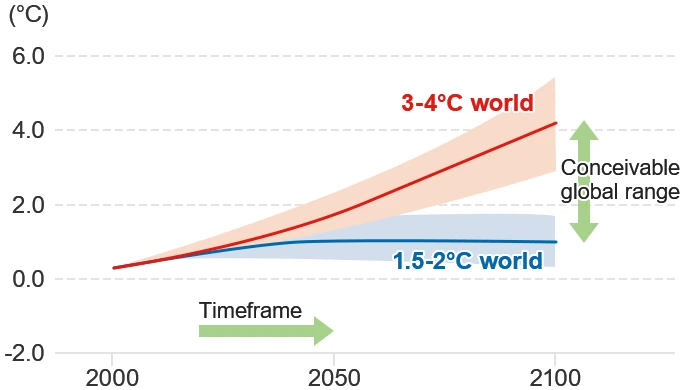
- Reference scenarios
-
- IEA World Energy Outlook 2018 SDS
- IEA “Net Zero Emissions by 2050”
- RCP2.6 and RCP8.5 in the IPCC’s Fifth Assessment Report
- 1.5 °C scenario from an IPCC special report, etc.
Expected risks and opportunities
Less than 2 °C (including 1.5 °C) scenario
| Category | Time span* | Details of risks and opportunities | Actions and initiatives | ||
|---|---|---|---|---|---|
| Risks | Transition | Policies and legal restrictions | Medium- to long-term |
|
|
| Short-, medium- and long-term |
|
|
|||
| Markets and reputations | Short-, medium- and long-term |
|
|
||
| Opportunities | Products, services and source of energy | Short-, medium- and long-term |
|
|
|
4°C scenario
| Category | Time span* | Details of risks and opportunities | Actions and initiatives | ||
|---|---|---|---|---|---|
| Risks | Physical | Acute | Short-, medium- and long-term |
|
|
| Short-, medium- and long-term |
|
|
|||
| Chronic | Short-, medium- and long-term |
|
|
||
| Opportunities | The market and resilience | Short-, medium- and long-term |
|
|
|
Impact on the COMSYS Group’s finances expected by 2030
| Category | Item | Below 2°C scenario (including 1.5 °C) |
|||
|---|---|---|---|---|---|
| Risks | Transition | Policies and legal restrictions | Carbon tax | Cost of taxation (GHG emissions reduction measures not implemented) |
Approx. 1.8 billion yen |
| Cost of taxation (if the target of a 42% reduction versus the FY2020 level is achieved) |
Approx. 1.1 billion yen | ||||
| Renewable energy-derived electricity rates | Electricity procurement costs increase | Approx. 0.06 billion yen | |||
Indicators and Targets
Targets for managing climate-related risks and opportunities and results (Scope 1, 2 and 3 emissions)
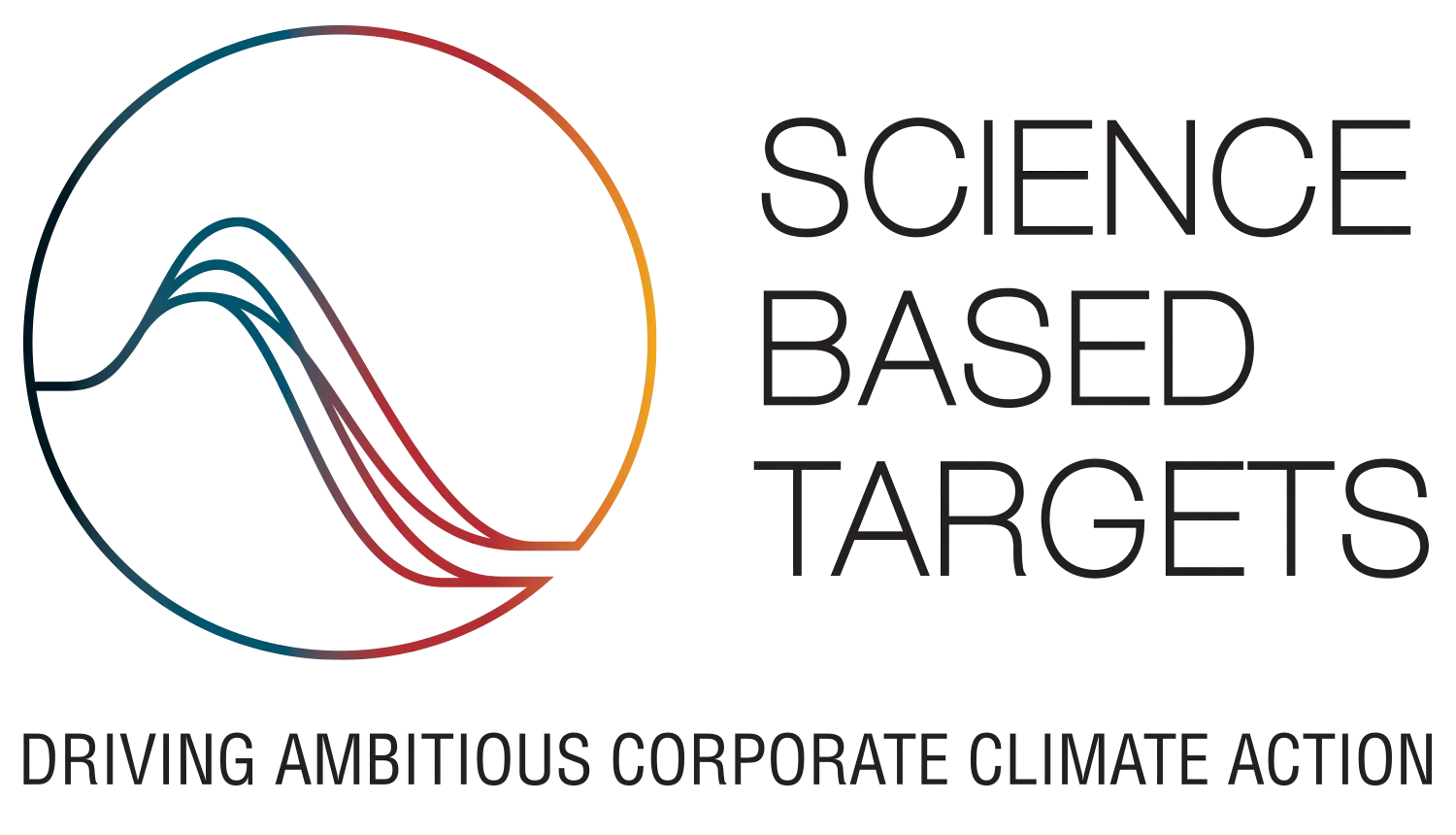
The COMSYS Group contributes to the continued reduction of the environmental impact of its business activities and the reduction of the environmental impact of society as a whole through our business operations. In this way, we continue with our activities for the realization of a sustainable society.
In May 2022, the COMSYS Group set targets based on the SBT concept and acquired the SBT certification of our FY2030 targets in October 2023. To accelerate our contributions to our activities to prevent climate change as a business, we set the target of reducing emissions by 21% by FY2025. We have also set the target of achieving virtually zero Scope 2 GHG emissions.
Actual reduction of greenhouse gas (GHG) emissions and targets

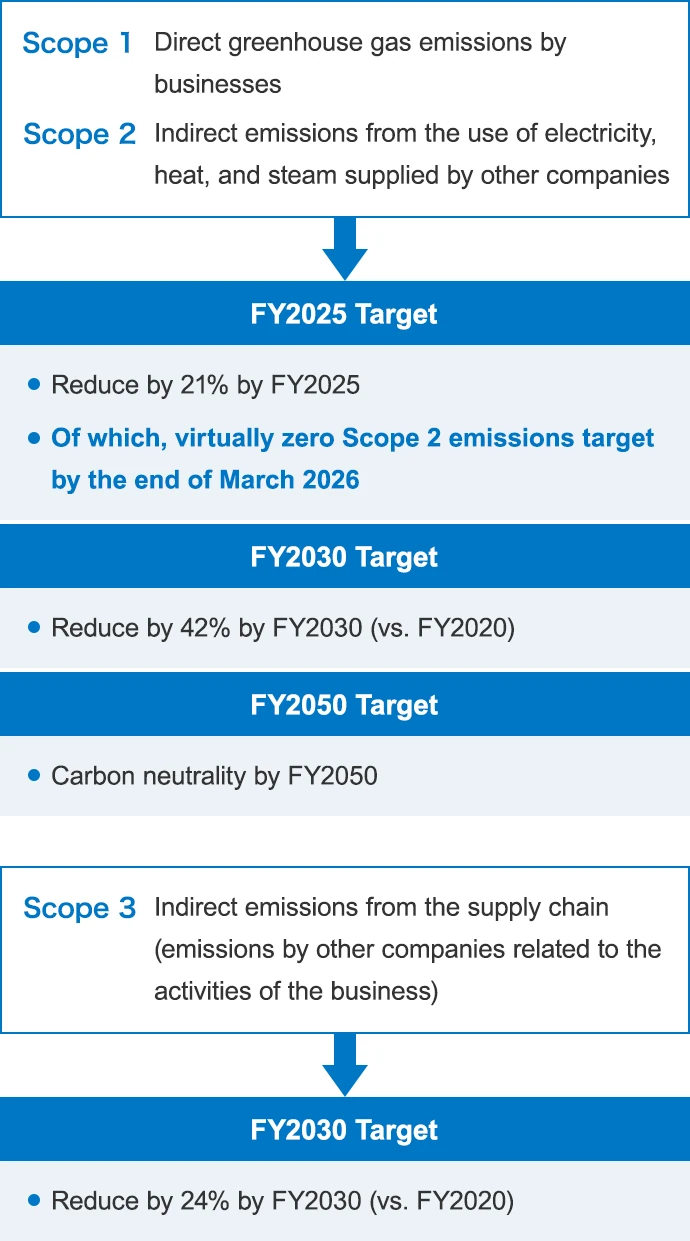
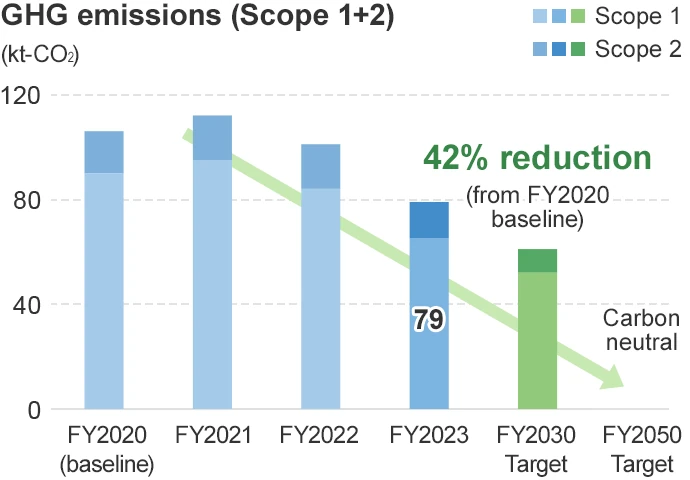
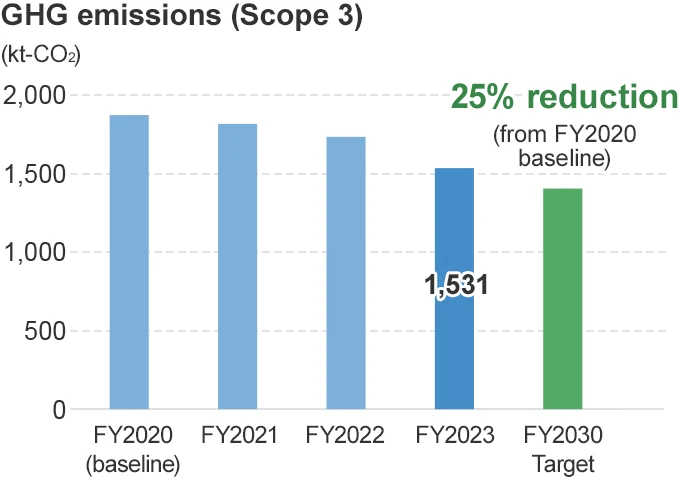
Energy consumption, greenhouse gas emissions
Breakdown of greenhouse gas (GHG) emissions
The COMSYS Group as a whole
| Scope / Category |
FY2020 (Base Year) | FY2021 | FY2022 | FY2023 | FY2024 |
|---|---|---|---|---|---|
| Scope 1+2 | 106 | 112 | 100 | 79 | 71 |
| Scope 1 (Direct emissions) |
90 | 95 | 84 | 65 | 67 |
| Scope2 (Indirect emissions) (on a market basis) |
16 | 17 | 17 | 14 | 4 |
| Scope 3 (total of the value chain) |
1,868 | 1,812 | 1,730 | 1,531 | 1,461 |
Major Initiatives
Reduction of fuel consumption by vehicles and construction machinery
Fuel consumption is nearly 80% of the GHG emissions from the COMSYS Group, but the electrification of construction machinery and biofuels have yet to reach a practical level. As a temporary solution, we have been adding combustion accelerant (K-S1) to enhance fuel efficiency.
Adding fuel accelerant at a 1:1000 accelerant-to-fuel ratio increases fuel efficiency 8%.

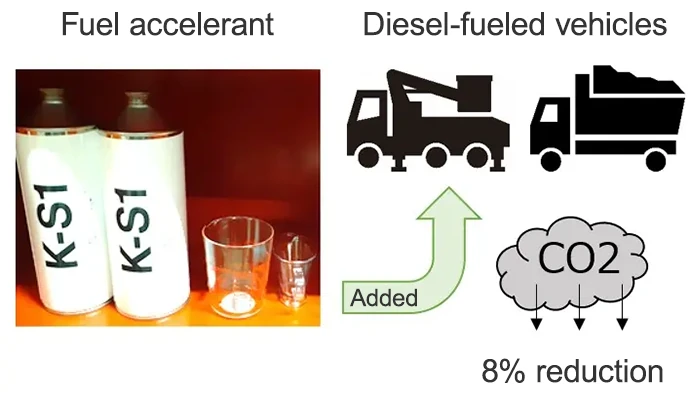
Switch to fuel-efficient vehicles (BEV, HEV)
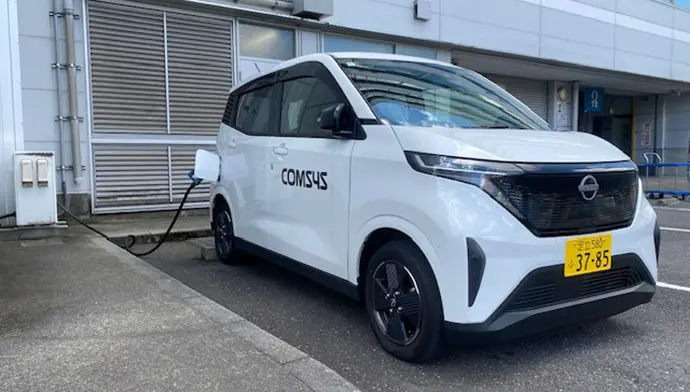
As the COMSYS Group is an information communication construction company mainly engaged in the construction of telecommunications infrastructure and social infrastructure, nearly 80% of the GHG emissions from the Group are from construction vehicles and machinery.
For this reason, the reduction of GHG emissions from vehicles is an important management issue for the COMSYS Group.
As a solution, we are encouraging the replacement of existing vehicles with hybrid vehicles (HEVs) and electric vehicles (BEVs), which are alternatives whose GHG emissions are lower. To date, however, HEV or BEV options are not yet available for special vehicles such as aerial work platforms. For this reason, we have started replacing vehicles beginning with general vehicles.
Promoting renewable energy businesses
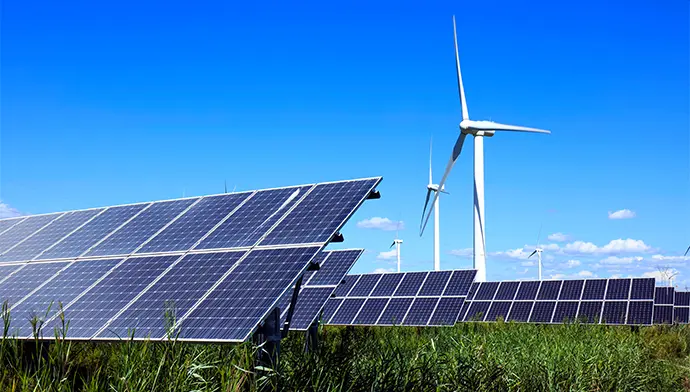
To achieve a decarbonized society, it is expected that companies and municipal governments will assume leadership roles and demand for renewable energy will grow. We will continue to work on this, leveraging our long track record and abundant expertise in the construction industry.
Use the COMSYS Group’s photovoltaic power plants to reduce Scope 2 emissions to zero

As part of the Group’s decarbonization initiatives, we have formulated a plan to only use electricity that is virtually renewable energy at all COMSYS Group locations by FY2025 by purchasing FIT non-fossil certificates with tracking* for the photovoltaic power plants owned by COMSYS Group company COMSYS Create Corporation. This plan has already commenced.
*Certificates separating the “non-fossil value” of electricity derived from non-fossil power source from the electricity generated by means of FIT (a system for the fixed purchase of renewable energy), with the addition of attribute information specifying the power station that generated the power.
The purchase of non-fossil certificates has been gradually expanded since FY2024 and certificates equivalent to the power consumption of all of our locations will be purchased in FY2025. This will help reduce the GHG emissions from the electricity consumption of the COMSYS Group to zero.
